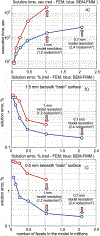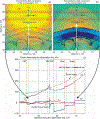Comparative performance of the finite element method and the boundary element fast multipole method for problems mimicking transcranial magnetic stimulation (TMS)
- PMID: 30605893
- PMCID: PMC6546501
- DOI: 10.1088/1741-2552/aafbb9
Comparative performance of the finite element method and the boundary element fast multipole method for problems mimicking transcranial magnetic stimulation (TMS)
Abstract
Objective: A study pertinent to the numerical modeling of cortical neurostimulation is conducted in an effort to compare the performance of the finite element method (FEM) and an original formulation of the boundary element fast multipole method (BEM-FMM) at matched computational performance metrics.
Approach: We consider two problems: (i) a canonic multi-sphere geometry and an external magnetic-dipole excitation where the analytical solution is available and; (ii) a problem with realistic head models excited by a realistic coil geometry. In the first case, the FEM algorithm tested is a fast open-source getDP solver running within the SimNIBS 2.1.1 environment. In the second case, a high-end commercial FEM software package ANSYS Maxwell 3D is used. The BEM-FMM method runs in the MATLAB® 2018a environment.
Main results: In the first case, we observe that the BEM-FMM algorithm gives a smaller solution error for all mesh resolutions and runs significantly faster for high-resolution meshes when the number of triangular facets exceeds approximately 0.25 M. We present other relevant simulation results such as volumetric mesh generation times for the FEM, time necessary to compute the potential integrals for the BEM-FMM, and solution performance metrics for different hardware/operating system combinations. In the second case, we observe an excellent agreement for electric field distribution across different cranium compartments and, at the same time, a speed improvement of three orders of magnitude when the BEM-FMM algorithm used.
Significance: This study may provide a justification for anticipated use of the BEM-FMM algorithm for high-resolution realistic transcranial magnetic stimulation scenarios.
Figures





Similar articles
-
A software toolkit for TMS electric-field modeling with boundary element fast multipole method: an efficient MATLAB implementation.J Neural Eng. 2020 Aug 4;17(4):046023. doi: 10.1088/1741-2552/ab85b3. J Neural Eng. 2020. PMID: 32235065
-
Preprocessing General Head Models for BEM-FMM Modeling Pertinent to Brain Stimulation.2020 Aug 6. In: Makarov SN, Noetscher GM, Nummenmaa A, editors. Brain and Human Body Modeling 2020: Computational Human Models Presented at EMBC 2019 and the BRAIN Initiative® 2019 Meeting [Internet]. Cham (CH): Springer; 2021. 2020 Aug 6. In: Makarov SN, Noetscher GM, Nummenmaa A, editors. Brain and Human Body Modeling 2020: Computational Human Models Presented at EMBC 2019 and the BRAIN Initiative® 2019 Meeting [Internet]. Cham (CH): Springer; 2021. PMID: 32966016 Free Books & Documents. Review.
-
Modeling transcranial magnetic stimulation coil with magnetic cores.J Neural Eng. 2023 Jan 25;20(1):016028. doi: 10.1088/1741-2552/acae0d. J Neural Eng. 2023. PMID: 36548994 Free PMC article.
-
A fast direct solver for surface-based whole-head modeling of transcranial magnetic stimulation.Res Sq [Preprint]. 2023 Jul 10:rs.3.rs-3079433. doi: 10.21203/rs.3.rs-3079433/v1. Res Sq. 2023. Update in: Sci Rep. 2023 Oct 31;13(1):18657. doi: 10.1038/s41598-023-45602-5. PMID: 37503106 Free PMC article. Updated. Preprint.
-
A survey on integral equations for bioelectric modeling.Phys Med Biol. 2024 Aug 28;69(17):10.1088/1361-6560/ad66a9. doi: 10.1088/1361-6560/ad66a9. Phys Med Biol. 2024. PMID: 39042098 Review.
Cited by
-
Pinpointing the precise stimulation targets for brain rehabilitation in early-stage Parkinson's disease.BMC Neurosci. 2023 Mar 29;24(1):24. doi: 10.1186/s12868-023-00791-7. BMC Neurosci. 2023. PMID: 36991320 Free PMC article.
-
Computation of transcranial magnetic stimulation electric fields using self-supervised deep learning.Neuroimage. 2022 Dec 1;264:119705. doi: 10.1016/j.neuroimage.2022.119705. Epub 2022 Oct 21. Neuroimage. 2022. PMID: 36280099 Free PMC article.
-
Precise Modulation Strategies for Transcranial Magnetic Stimulation: Advances and Future Directions.Neurosci Bull. 2021 Dec;37(12):1718-1734. doi: 10.1007/s12264-021-00781-x. Epub 2021 Oct 5. Neurosci Bull. 2021. PMID: 34609737 Free PMC article. Review.
-
Rapid computation of TMS-induced E-fields using a dipole-based magnetic stimulation profile approach.Neuroimage. 2021 Aug 15;237:118097. doi: 10.1016/j.neuroimage.2021.118097. Epub 2021 Apr 30. Neuroimage. 2021. PMID: 33940151 Free PMC article.
-
Involvement of aSPOC in the Online Updating of Reach-to-Grasp to Mechanical Perturbations of Hand Transport.J Neurosci. 2025 Mar 19;45(12):e0173242025. doi: 10.1523/JNEUROSCI.0173-24.2025. J Neurosci. 2025. PMID: 39870529
References
-
- Balay S. et al. PETSc Users Manual (Argonne National Laboratory) ANL-95/11—Revision 3.9. 2018 Online: http://mcs.anl.gov/petsc.
-
- Bangerth W, Hartmann R and Kanschat G 2007. Deal.II—a generalpurpose object-oriented finite element library ACM Trans. Math. Softw 33 24
-
- Bleszynski E, Bleszynski M and Jaroszewicz T 1996. AIM: adaptive integral method for solving large-scale electromagnetic scattering and radiation problems Radio Sci 31 1225–51
Publication types
MeSH terms
Grants and funding
LinkOut - more resources
Full Text Sources
Other Literature Sources
Molecular Biology Databases
